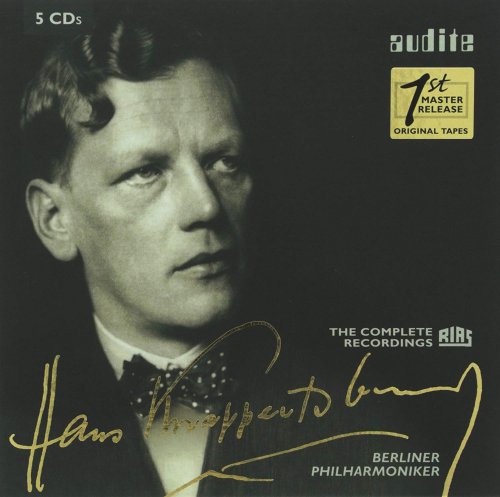Hans Knappertsbusch - The Complete RIAS Recordings (5CD) (2010)

Artist: Hans Knappertsbusch
Title: The Complete RIAS Recordings
Year Of Release: 2010
Label: Audite
Genre: Classical
Quality: APE (image+.cue,log,scans)
Total Time: 355:04
Total Size: 1,17 Gb
WebSite: Album Preview
Tracklist: Title: The Complete RIAS Recordings
Year Of Release: 2010
Label: Audite
Genre: Classical
Quality: APE (image+.cue,log,scans)
Total Time: 355:04
Total Size: 1,17 Gb
WebSite: Album Preview
CD 1:
ANTON BRUCKNER - Symphony No. 9 in D minor
I. Feierlich, misterioso (22:31)
II. Scherzo. Bewegt, lebhaft – Trio. Schnell (11:13)
III. Adagio. Langsam, feierlich (22:02)
FRANZ SCHUBERT - Symphony No. 8 in B minor, D.759, 'Unfinished Symphony'
I. Allegro moderato (12:03)
II. Andante con moto (11:16)
CD 2:
ANTON BRUCKNER - Symphony No. 8 in C minor
I. Allegro moderato (15:05)
II. Scherzo. Allegro moderato (14:03)
III. Adagio. Feierlich langsam; doch nicht schleppend (26:55)
IV. Finale. Feierlich, nicht schnell (22:35)
CD 3:
LUDWIG VAN BEETHOVEN - Symphony No. 8 in F Major, Op. 93
I. Allegro vivace e con brio (10:11)
II. Allegretto scherzando (04:24)
III. Tempo di Menuetto (05:28)
IV. Allegro vivace (08:18)
JOHANN STRAUSS - One Thousand and One Nights
Intermezzo (09:10)
OTTO NICOLAI - The Merry Wives of Windsor
Ouverture (08:57)
JOSEPH HAYDN - Symphony No. 94 in G major 'Surprise Symphony'
I. Adagio cantabile (07:34)
II. Andante (07:11)
III. Menuetto Allegro molto (05:25)
IV. Finale Allegro molto (04:32)
CD 4:
PETER ILYICH TCHAIKOVSKY - The Nutcracker Suite, Op. 71a
I. Miniature Overture. Allegro giusto (03:31)
II. Danses caractéristiques - a. Marche: Tempo di marcia viva (02:37)
II. Danses caractéristiques - b. Dance of the Sugar-Plum Fairy: Andante... (01:39)
II. Danses caractéristiques - c. Russian Dance (Trepak): Tempo di trepak,... (01:07)
II. Danses caractéristiques - d. Arabian Dance: Allegretto (03:38)
II. Danses caractéristiques - e. Chinese Dance: Allegro moderato (01:09)
II. Danses caractéristiques - f. Reed-Flutes: Moderato assai (02:37)
III. Waltz of the Flowers: Tempo di Valse (07:16)
JOHANN STRAUSS - Die Fledermaus
Ouverture (08:10)
JOHANN STRAUSS
Pizzikato Polka (02:55)
Bad’ner Mad’ln (10:19)
FRANZ SCHUBERT- Symphony No. 8 in B minor, D.759, 'Unfinished Symphony'
I. Allegro moderato (12:20)
II. Andante con moto (11:51)
CD 5:
ANTON BRUCKNER - Symphony No. 9 in D minor
I. Feierlich, misterioso (22:33)
II. Scherzo. Bewegt, lebhaft – Trio. Schnell (11:20)
III. Adagio. Langsam, feierlich (23:25)
Performers:
Berliner Philharmoniker
Hans Knappertsbusch, conductor
Audite’s access to master tapes and its ability to present splendidly annotated boxes is proving an increasingly notable feature of the reissue market. True, there is a degree of congestion and multiplication in this field, with competing labels putting out the same recording in transfers of varying degrees of skill and sensitivity. And with Knappertsbusch, the repertoire was not vast; and no great surprises await.
But for the core repertory, and for the lighter muse too – and his humour was never especially droll, tending toward the guttural, if not indeed the blue – Kna is very much a collectors’ favourite. This five disc box ticks many of the relevant boxes, though there is duplication even within it – two Schubert Unfinished performances and two Bruckner Nines.
These are all RIAS (Radio in the American Sector of Berlin) performances given with the Berlin Philharmonic between 1950 and 1952 (why do English language writers now routinely refer to this band as the Berliner Philharmoniker? When was the last time they called Prague ‘Praha’?).
Kna was an often inspired Bruckner conductor, though occasionally, it’s true, a sloppy one. Seven Seas have actually also issued this 1951 Berlin No.8 on KICC2027 and Hunt likewise on CD711 and so too Andromeda in their 6 CD box devoted to the conductor’s Bruckner [ANDRCD 9010]. Music and Arts issued the Bavarian State 1955 performance, Memories dug out the VPO, and MCA offered the commercial 1963 Munich recording. It’s as well that we hear the Berlin performance and not the Munich because the former is an infinitely better performed piece of work and not subject to nearly so many orchestral mishaps. Textual matters will be of concern to listeners but seen in the light of his Bruckner performances generally they are surely subordinate to the sense of massive characterisation and eloquence that the conductor generates. Even if I think this a lesser performances than say his recordings of the Seventh and the Fifth, it still stands as a kind of monument to Knappertsbusch’s Bruckner conducting.
There are two Ninths; the studio version comes from 28 January 1950 and the live one from two days later — both were taped in the Titania–Palast. These have also seen the rounds. For example the studio version has been issued by Music and Arts CD219 and Foyer has also issued it [CDS16004], in addition to the Andromeda noted above. The only other Ninth known to me to be around is the February 1958 Bavarian State on Hunt CD710 – this company had a run of Symphonies Nos.7-9. The Ninth is heard in the Löwe revision. Kna employs a full panoply of expressive devices, huge dynamics and powerful contrasts, to make his points. As before and in contradistinction to the views of many of his detractors, he does not do so through the expedient of slow tempi.
The two Schubert performances are not at all duplicatory, given the conductor’s newly minted character. The first (28 January 1950) is the studio recording, whilst two days later followed this live traversal. He takes his time but freights both with gravity and his own brand of intensity. Of the two, I do marginally prefer the studio reading but some may prefer the slightly broader second movement of the live performance. Beethoven’s Eighth Symphony (29 January 1952) is strongly argued but not without the conductor’s usual humour. Those expecting a trudge will be disappointed, because Kna keeps things appositely on the move, even when sonority is heavily hewn. Haydn’s Surprise Symphony comes from a live broadcast in February 1950 and is another example of symphonic literature well tailored to the conductor’s own sense of things – now imposing, now humorous. The Nutcracker suite is hardly in the Stokowski class as regards flair, colour and pointing, but it has solid virtues of its own, rather symphonic ones in fact. There are also some genial examples of his way with Johann Strauss II, Nicolai, and Karel Komzák II. These come as engaging contrast to the heavy duty Brucknerian fare, in particular, elsewhere in the set.
The transfers are the finest now to be heard of this material and the booklet has been compiled with care and intelligence. -- Jonathan Woolf
But for the core repertory, and for the lighter muse too – and his humour was never especially droll, tending toward the guttural, if not indeed the blue – Kna is very much a collectors’ favourite. This five disc box ticks many of the relevant boxes, though there is duplication even within it – two Schubert Unfinished performances and two Bruckner Nines.
These are all RIAS (Radio in the American Sector of Berlin) performances given with the Berlin Philharmonic between 1950 and 1952 (why do English language writers now routinely refer to this band as the Berliner Philharmoniker? When was the last time they called Prague ‘Praha’?).
Kna was an often inspired Bruckner conductor, though occasionally, it’s true, a sloppy one. Seven Seas have actually also issued this 1951 Berlin No.8 on KICC2027 and Hunt likewise on CD711 and so too Andromeda in their 6 CD box devoted to the conductor’s Bruckner [ANDRCD 9010]. Music and Arts issued the Bavarian State 1955 performance, Memories dug out the VPO, and MCA offered the commercial 1963 Munich recording. It’s as well that we hear the Berlin performance and not the Munich because the former is an infinitely better performed piece of work and not subject to nearly so many orchestral mishaps. Textual matters will be of concern to listeners but seen in the light of his Bruckner performances generally they are surely subordinate to the sense of massive characterisation and eloquence that the conductor generates. Even if I think this a lesser performances than say his recordings of the Seventh and the Fifth, it still stands as a kind of monument to Knappertsbusch’s Bruckner conducting.
There are two Ninths; the studio version comes from 28 January 1950 and the live one from two days later — both were taped in the Titania–Palast. These have also seen the rounds. For example the studio version has been issued by Music and Arts CD219 and Foyer has also issued it [CDS16004], in addition to the Andromeda noted above. The only other Ninth known to me to be around is the February 1958 Bavarian State on Hunt CD710 – this company had a run of Symphonies Nos.7-9. The Ninth is heard in the Löwe revision. Kna employs a full panoply of expressive devices, huge dynamics and powerful contrasts, to make his points. As before and in contradistinction to the views of many of his detractors, he does not do so through the expedient of slow tempi.
The two Schubert performances are not at all duplicatory, given the conductor’s newly minted character. The first (28 January 1950) is the studio recording, whilst two days later followed this live traversal. He takes his time but freights both with gravity and his own brand of intensity. Of the two, I do marginally prefer the studio reading but some may prefer the slightly broader second movement of the live performance. Beethoven’s Eighth Symphony (29 January 1952) is strongly argued but not without the conductor’s usual humour. Those expecting a trudge will be disappointed, because Kna keeps things appositely on the move, even when sonority is heavily hewn. Haydn’s Surprise Symphony comes from a live broadcast in February 1950 and is another example of symphonic literature well tailored to the conductor’s own sense of things – now imposing, now humorous. The Nutcracker suite is hardly in the Stokowski class as regards flair, colour and pointing, but it has solid virtues of its own, rather symphonic ones in fact. There are also some genial examples of his way with Johann Strauss II, Nicolai, and Karel Komzák II. These come as engaging contrast to the heavy duty Brucknerian fare, in particular, elsewhere in the set.
The transfers are the finest now to be heard of this material and the booklet has been compiled with care and intelligence. -- Jonathan Woolf





![Zbigniew Namyslowski Modern Jazz Quartet - Lola (Remastered 2025) (2025) [Hi-Res] Zbigniew Namyslowski Modern Jazz Quartet - Lola (Remastered 2025) (2025) [Hi-Res]](https://www.dibpic.com/uploads/posts/2025-12/1765509687_cover.jpg)


